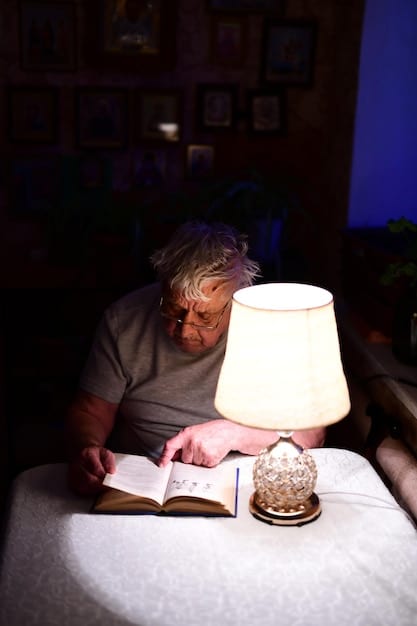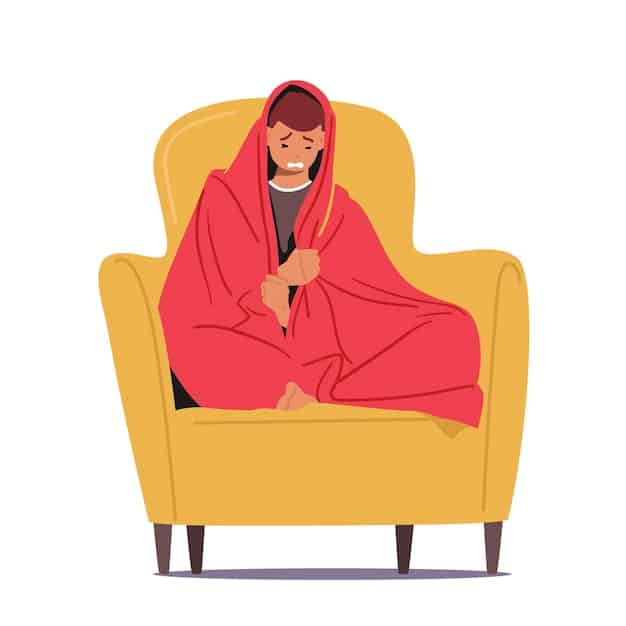Understanding SAD in the US: Symptoms & Winter 2025 Solutions

Understanding Seasonal Affective Disorder (SAD) in the US: Symptoms and Solutions for Winter 2025 involves recognizing the symptoms linked to reduced sunlight and exploring effective strategies like light therapy and cognitive behavioral therapy to manage and alleviate this condition.
As winter approaches, shorter days and less sunlight can trigger mood changes for many. Understanding Seasonal Affective Disorder (SAD) in the US: Symptoms and Solutions for Winter 2025 is crucial for those who experience these seasonal shifts, helping them recognize symptoms and find effective ways to cope.
What is Seasonal Affective Disorder (SAD)?
Seasonal Affective Disorder (SAD) is more than just the “winter blues.” It’s a type of depression that’s related to changes in seasons, beginning and ending at about the same times every year. Let’s delve deeper into what defines SAD and how it impacts individuals.
Understanding the Definition
SAD is characterized by recurrent depressive episodes in a seasonal pattern. This generally means that the symptoms start in the fall and continue into the winter months, subsiding during the spring and summer.
To be diagnosed with SAD, a person must meet the criteria for major depression, and the seasonal pattern must be evident for at least two years. It’s essential to differentiate SAD from other forms of depression that may simply worsen during the winter months.

Who is Affected by SAD?
- Geographic Location: SAD is more prevalent in regions farther from the equator, where there are significant changes in daylight hours during the winter.
- Age and Gender: While SAD can affect anyone, it is more commonly diagnosed in women and younger adults.
- Pre-existing Conditions: People with a history of depression or other mood disorders are more likely to experience SAD.
Understanding who is at a higher risk can help individuals and healthcare providers be more vigilant about recognizing and addressing symptoms early on.
In conclusion, SAD is a specific type of depression linked to seasonal changes, primarily affecting individuals in areas with significant variations in daylight. Recognizing the definition and the factors that increase susceptibility are crucial steps in understanding and managing this condition.
Recognizing SAD Symptoms in Winter 2025
Identifying SAD symptoms early can make a significant difference in managing the condition. The symptoms often mimic those of major depression, but with a seasonal twist. Here’s what to look for as winter 2025 approaches.
Common Emotional and Psychological Symptoms
Emotional and psychological symptoms are often the most noticeable aspects of SAD. These can significantly impact daily life and overall well-being.
Individuals may experience persistent feelings of sadness, hopelessness, or anxiety. Irritability, a loss of interest in usual activities, and decreased energy levels are also common. It’s important to note that these feelings are more than just a passing mood; they are persistent and debilitating.
Physical Symptoms to Watch For
SAD also manifests through physical symptoms, which can be just as challenging to deal with. Recognizing these physical signs is vital for comprehensive management.
Changes in sleep patterns, such as oversleeping or insomnia, are frequent. Other physical symptoms include changes in appetite, often with cravings for carbohydrates, leading to weight gain. Fatigue and a general sense of sluggishness are also commonly reported.

Differentiating SAD from Other Depressive Disorders
- Timing: SAD symptoms typically emerge in the fall and winter, improving in the spring and summer.
- Specific Symptoms: SAD often involves oversleeping, increased appetite (especially for carbs), and weight gain, whereas other depressive disorders may present with insomnia and weight loss.
- Seasonal Pattern: A consistent seasonal pattern over at least two years is a key diagnostic criterion for SAD.
In summary, recognizing SAD symptoms involves identifying both emotional and physical changes that are consistent with the seasonal pattern. Differentiating SAD from other depressive disorders is crucial for accurate diagnosis and effective treatment.
The Science Behind Seasonal Mood Changes
Understanding the biological mechanisms behind SAD can provide valuable insights into why certain treatments are effective. The main factors involve changes in light exposure and their effects on brain chemistry.
The Role of Sunlight and Vitamin D
Sunlight plays a crucial role in regulating our mood and overall well-being. During the winter months, reduced sunlight can lead to several biological changes.
Sunlight helps the body produce vitamin D, which is essential for bone health and immune function. Low vitamin D levels have been linked to depression and other mood disorders. Additionally, sunlight affects the production of serotonin and melatonin, neurotransmitters that regulate mood and sleep.
Neurotransmitter Imbalances
Neurotransmitters like serotonin and melatonin are significantly impacted by seasonal changes in light exposure.
Serotonin, often referred to as the “happy hormone,” helps regulate mood, appetite, and sleep. Reduced sunlight can lead to lower serotonin levels, contributing to depressive symptoms. Melatonin, which regulates sleep-wake cycles, is produced in response to darkness. In winter, increased melatonin production can disrupt the body’s natural rhythms, leading to fatigue and sleep disturbances.
Impact on Circadian Rhythm
- Disruption of Sleep-Wake Cycles: Shorter days can disrupt the body’s internal clock, making it difficult to maintain a regular sleep schedule.
- Hormonal Changes: Altered circadian rhythms can affect the timing and duration of hormone release, influencing mood and energy levels.
- Overall Health: Chronic disruption of circadian rhythms has been linked to a variety of health problems, including increased risk of depression and other mood disorders.
In essence, seasonal mood changes are influenced by the interplay of sunlight, vitamin D levels, neurotransmitter balance, and circadian rhythm. Understanding these factors can help individuals and healthcare providers tailor effective strategies to manage SAD.
Light Therapy: A Bright Solution for SAD
Light therapy is one of the primary treatments for SAD, involving exposure to bright, artificial light that mimics natural sunlight. The goal is to compensate for the reduced sunlight during the winter months.
How Light Therapy Works
Light therapy works by influencing brain chemicals linked to mood and sleep. Exposure to bright light can help regulate serotonin and melatonin levels, improving mood and re-establishing a normal sleep-wake cycle.
Typically, light therapy involves sitting near a light box that emits bright, full-spectrum light for about 20 to 30 minutes each day. The light box should provide an intensity of about 10,000 lux, and it’s essential to use it safely, avoiding direct eye contact.
Choosing the Right Light Box
Selecting the right light box is crucial to ensure its effectiveness and safety. Consider the following factors when making a purchase:
Look for light boxes that emit 10,000 lux and filter out harmful UV rays. Choose a device that is certified by reputable organizations and has been tested for safety and efficacy. Portable light boxes are convenient for travel, while larger models may be more suitable for home use.
Tips for Effective Light Therapy
- Consistency: Use the light box at the same time each day, preferably in the morning, to help regulate your circadian rhythm.
- Distance and Angle: Follow the manufacturer’s instructions for the recommended distance and angle to ensure you’re receiving the optimal amount of light.
- Duration: Start with shorter sessions and gradually increase the duration to 20 to 30 minutes, as tolerated.
In summary, light therapy is a valuable tool for managing SAD, and it involves daily exposure to bright, artificial light. Choosing the right light box and using it consistently and correctly can help alleviate symptoms and improve overall well-being during the winter months.
Cognitive Behavioral Therapy (CBT) for SAD
Cognitive Behavioral Therapy (CBT) is another effective treatment option for SAD. It focuses on identifying and changing negative thought patterns and behaviors that contribute to depressive symptoms.
Understanding CBT Principles
CBT is based on the principle that our thoughts, feelings, and behaviors are interconnected. By altering negative or unhelpful thought patterns, individuals can improve their mood and behavior.
In the context of SAD, CBT helps individuals identify and challenge negative thoughts related to the winter season and limited daylight. It also focuses on developing coping strategies to manage symptoms and engage in activities that promote well-being.
How CBT Helps with SAD
CBT addresses the psychological aspects of SAD, providing individuals with tools to manage their thoughts and behaviors effectively. Common techniques include:
Cognitive restructuring involves identifying and challenging negative thought patterns. Behavioral activation focuses on increasing engagement in enjoyable and meaningful activities to combat isolation and low motivation. Stress management techniques, such as relaxation exercises and mindfulness, can help reduce anxiety and improve overall coping skills.
Finding a Qualified Therapist
- Credentials: Look for a therapist who is licensed and has experience treating individuals with mood disorders, particularly SAD.
- Specialization: Seek out therapists who specialize in CBT, as this approach is particularly well-suited for addressing the cognitive and behavioral aspects of SAD.
- Fit: Finding a therapist with whom you feel comfortable and understood is crucial for successful therapy.
To conclude, Cognitive Behavioral Therapy is a valuable treatment for SAD, focusing on altering negative thought patterns and behaviors. Finding a qualified therapist who specializes in CBT can provide individuals with the tools and support they need to manage their symptoms and improve their quality of life during the winter months.
Lifestyle Adjustments to Combat SAD
In addition to light therapy and CBT, several lifestyle adjustments can help manage SAD symptoms. These changes focus on promoting overall well-being and coping with the challenges of the winter season.
The Importance of Diet and Exercise
A healthy diet and regular exercise are essential for maintaining physical and mental health. They can play a significant role in alleviating SAD symptoms.
Focus on a balanced diet rich in fruits, vegetables, and whole grains. Limit processed foods, sugary snacks, and excessive caffeine. Regular exercise, even moderate activity like walking or yoga, can boost mood, reduce stress, and improve sleep.
Creating a Supportive Environment
A supportive environment can significantly impact how you cope with SAD. Surround yourself with positive influences and make your living space conducive to well-being.
Ensure your home is well-lit and inviting. Spend time with loved ones and engage in social activities that bring you joy. Incorporate elements of self-care, such as taking warm baths, reading, or listening to music.
Strategies for Coping with Winter Blues
- Plan Activities: Schedule enjoyable activities throughout the winter to look forward to.
- Stay Connected: Make an effort to maintain social connections and avoid isolation.
- Embrace the Season: Find ways to appreciate the winter, such as going for walks in the snow, enjoying seasonal foods, or engaging in winter sports.
Overall, lifestyle adjustments are a crucial part of managing SAD symptoms. Prioritizing a healthy diet, exercise, creating a supportive environment, and implementing coping strategies can significantly improve your well-being during the winter months.
Medication and Other Treatment Options
In some cases, medication may be necessary to manage SAD symptoms. Additionally, there are other treatment options available that can complement light therapy, CBT, and lifestyle adjustments.
When to Consider Medication
Medication may be considered when SAD symptoms are severe and significantly impact daily functioning. It’s essential to consult with a healthcare provider to determine the best course of action.
Antidepressants, particularly selective serotonin reuptake inhibitors (SSRIs), are commonly prescribed for SAD. These medications help regulate serotonin levels in the brain, alleviating depressive symptoms. It’s crucial to discuss potential side effects and monitor the effectiveness of the medication with your doctor.
Alternative Therapies
In addition to conventional treatments, some individuals find relief through alternative therapies. These may include:
Vitamin D supplements can help compensate for the reduced production of vitamin D during the winter months. Acupuncture and massage therapy can help reduce stress and improve overall well-being. Herbal remedies, such as St. John’s Wort, have been used to treat depression, but it’s essential to consult with a healthcare provider before using them.
Combining Treatments for Best Results
- Individualized Approach: The best treatment plan for SAD often involves a combination of therapies tailored to the individual’s needs and preferences.
- Monitoring and Adjustment: It’s essential to monitor the effectiveness of each treatment and make adjustments as needed, in consultation with your healthcare provider.
- Long-Term Management: SAD is a recurrent condition, so long-term management strategies are crucial for maintaining well-being year after year.
To summarize, while light therapy and CBT are the primary treatments for SAD, medication and other therapies may be necessary for some individuals. Combining treatments and working closely with a healthcare provider can help achieve the best possible results.
| Key Point | Brief Description |
|---|---|
| ☀️ Light Therapy | Use of a light box to mimic natural sunlight, helping to regulate mood and sleep. |
| 🧠 CBT | Therapy that focuses on changing negative thought patterns and behaviors to improve mental well-being. |
| 💪 Lifestyle | Adjustments such as diet, exercise, and creating a supportive environment to alleviate symptoms. |
| 💊 Medication | In some cases, antidepressants can help regulate neurotransmitter levels and improve mood. |
Frequently Asked Questions (FAQ)
▼
The main symptoms include persistent sadness, loss of interest in activities, fatigue, changes in appetite, and sleep disturbances. These symptoms usually appear in the fall and winter months.
▼
Light therapy helps by mimicking natural sunlight, which can regulate serotonin and melatonin levels in the brain. This regulation helps to improve mood and normalize sleep-wake cycles.
▼
Yes, regular exercise can alleviate SAD symptoms. Exercise boosts mood, reduces stress, and improves sleep, all of which can help combat the effects of seasonal depression.
▼
Medication is sometimes used to treat SAD, especially when symptoms are severe. Antidepressants like SSRIs can help regulate neurotransmitter levels and improve mood.
▼
Creating a supportive environment involves ensuring your home is well-lit, spending time with loved ones, engaging in social activities, and incorporating self-care practices like warm baths or reading.
Conclusion
In conclusion, understanding Seasonal Affective Disorder (SAD) in the US: Symptoms and Solutions for Winter 2025 involves recognizing the unique challenges posed by reduced sunlight and implementing strategies such as light therapy, CBT, lifestyle adjustments, and, when necessary, medication. By being proactive and informed, individuals can manage their symptoms effectively and maintain their well-being throughout the winter months.





